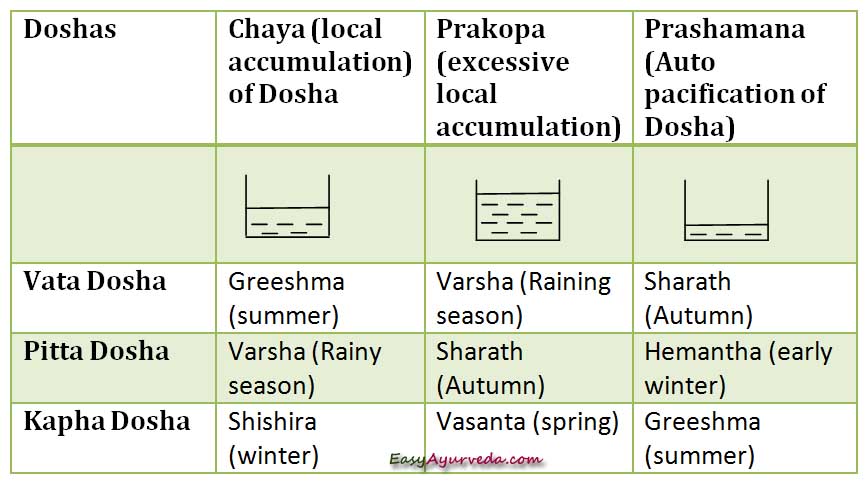Relationship Of Doshas With Seasons
By Dr Raghuram Y.S. MD (Ay) & Dr Manasa, B.A.M.S
Doshas and seasons i.e Rutus occurring in a year have strong bonding. Doshas respond to changes occurring in seasons in form of undergoing increase and decrease.
Table of Contents
Introduction

According to Indian calendar and explanation given in Ayurvedic texts in context of Seasonal Regimen, seasons are six in number. They are –
- Shishira Rtu – Late winter season
- Vasanta Rtu – Spring season
- Greeshma Rtu – Summer season
- Varsha Rtu – Monsoon or rainy season
- Sharad Rtu – Autumn season
- Hemanta Rtu – Early winter season
Read – Ritucharya – Healthy Seasonal Regimen – Introduction, Divisions
First three among these seasons are called as Adana Kala, i.e. heat predominant seasons. Sun is said to be predominant in these seasons. Each season is of 2 months. Hence three seasons of adana kala cover 6 months. Similarly other three seasons of visarga kala cover rest of 6 months of year.
Read – Uttarayana – Adana Kala (Northern Solstice) Definition, Seasons, Effect On Health
Last three seasons are called Visarka Kala, i.e. cold predominant seasons. Moon is said to be predominant in these seasons. Like in adana kala, here too each season is of 2 months and cover 6 months of year.
Dosha-Ritu Relationship
In response to seasons, doshas show three types of response. They are –
- Sanchaya (Chaya) – natural accumulation of doshas in particular seasons favorable for their accumulation
- Prakopa (Kopa) – natural aggravation of doshas in next season (season following sanchaya season) favorable for their aggravation
- Prashama (Shamana) – natural decrease of doshas towards their normal state in next season (season following prakopa season) favorable for their decrease
Read – Dosha Chaya, Kopa, Shamana – Accumulation, Aggravation, Auto-pacification
Table

Progression of Dosha vitiation
In healthy people, in those following rules and regulations of seasonal regimen and in those having good immunity, these stages will naturally occurs and doshas will settle down. In those with less immunity and in those who do not follow rules and regulations of seasonal regimen, doshas do not undergo auto-pacification. In fact doshas will further increase and further get vitiated in a graphical way. Dosha vitiation which had occurred in season meant for aggravation i.e. doshas which have undergone increase, instead of getting pacified will undergo further stages of pathogenesis and will progress towards causing disease. These stages are –
- Prasara – prasara means to spread. This is a stage which occurs following increase. Aggravated doshas in season favorable for aggravation doshas will leave their seats and overflow so as to spread to other places (tissues and organs) of body.
- Sthana samshraya – doshas which have undergone overflow in prasara stage will find weak and susceptible organs and tissues and get lodged in them. This is stage of lodgment of doshas and lodgmentis called sthana samshraya. When doshas get lodged in tissues, reaction between doshas and tissues will lead to formation of premonitory symptoms of disease. Amalgamation of vitiated doshas and weak tissues is called doshadushya sammurchana. Disease process begins in this stage.
- Vyakta or vyaktibhava – In this stage amalgamation of doshas and tissues will further strengthen. There is further destruction of tissues. This tissue damage will lead to formation of signs and symptoms of disease. These signs and symptoms help in diagnosing disease and hence mark onset of disease in its full form. Vyakta means manifestation. In this case vyakta means manifestation of disease.
- Bheda avastha – This is a stage of complications. When disease is not treated properly in vyakta stage, complications are formed and this stage is called bheda stage. This stage is difficult to treat or disease becomes incurable in this stage
Read – Normal Vitiation of Doshas As Per Seasonal Variation
Above said four stages of pathogenesis together with sanchaya and prakopa explained earlier form 6 stages of pathogenesis disease (samprapti) in that order. They are called Shat Kriya Kala i.e. 6 stages of pathogenesis wherein quick action in each stage prevents manifestation of upcoming stage and would abort disease process in earlier stages itself.
First three stages i.e. sanchaya, prakopa and prasara are stages of vitiation of doshas. Each successive stage is stronger than its previous stage. Disease is not yet formed here. These stages are called Dosha Kriya Kalas because only doshas are vitiated in various gradients in these stages. Sanchaya, Prakopa and Prashamana are called rutu kriya kala because they naturally occur in seasons and due to seasonal changes as explained above. When dosha pacification doesn’t take place, it progresses to prasara.
Read – Relationship between Samprapti and Shat Kriya Kala
Last three stages of pathogenesis are called vyadhi kriya kala which means that disease is formed in these stages.
Read – Samprapti Vighatana in Vyadhi Kriya Kala – Breaking Pathogenesis
Treatment perspective
Treatment perspective – From treatment perspective, earlier stages of pathogenesis are easy to treat where as end stages are difficult to treat or incurable. Thus, sanchaya stage is easier to treat and bheda stage is incurable. If dosha variations are identified and diagnosed at earliest and proper timely interventions are adapted, successive stages of pathogenesis are not formed and disease is aborted in earlier stages itself
Read – Samprapti Vighatan in Dosha Kriya Kala – Breaking Early Stage Pathogenesis
Vata – Seasonal variation
Vata Dosha in relation to seasonal variations
Accumulation of vata dosha takes place in summer season. Due to excessive dryness of climate, vata gets accumulated. Vata doesn’t get aggravated because of prevailing heat in season, heat being antagonistic to cold quality of vata.
Read – Ayurvedic Health Tips For Summer Season
Aggravation of vata takes place in next season i.e. monsoon season. In this season dryness of climate is associated with coldness; both qualities of nature are similar to qualities of vata and are hence favorable to cause its aggravation.
Read – Diet And Lifestyle Advice For Vata Dosha Body Type
Auto-pacification of vata takes place in next season i.e. autumn season. This season is marked by excess of heat and unctuousness, both qualities being opposite to that of vata will cause pacification of vata.
If seasonal regimen is not followed vata prakopa progresses towards prasara etc pathogenic stages and causes vata disorders instead of getting pacified. If seasonal regimen is followed, vata naturally regresses and comes back to normalcy in autumn season.
Pitta – Seasonal variation
Pitta Dosha in relation to seasonal variations
Accumulation of pitta dosha takes place in monsoon season. Due to excessive rain in this season all vegetation and foods and medicines would have got sourness. Due to consumption of sour rich foods and medicines, pitta will get accumulated, sour taste being pitta aggravating taste. But pitta doesn’t get aggravated because of coldness prevailing in this season, coldness being opposite to hot quality of pitta.
Aggravation of pitta takes place in next season i.e autumn season. In this season prevailing heat and unctuousness will cause aggravation of pitta since both these qualities of season are alike those of pitta and are hence favorable for its aggravation.
Read – Ayurvedic Pitta Diet – food suitable for Pitta body type
Auto-pacification of pitta takes place in next season i.e. early winter season. This season is marked by excess of coldness and dryness, both qualities being opposite to that of pitta will cause pacification of pitta.
If seasonal regimen is not followed pitta aggravation progresses towards prasara etc pathogenic stages and causes many pitta disorders instead of getting pacified. If seasonal regimen is followed, pitta naturally regresses and comes back to normalcy in early winter season.
Read – Ayurvedic Seasonal Regimen Based on Different Climatic Conditions
Kapha – Seasonal variation
Kapha Dosha in relation to seasonal variations
Accumulation of kapha dosha takes place in late winter season. Due to excessive coldness and dryness prevailing in season, kapha accumulation takes place. Excessive coldness will cause consolidation of kapha and hence its accumulation. But kapha doesn’t get aggravated because of prevailing dryness in season, dryness being antagonistic to unctuous quality of kapha.
Aggravation of kapha takes place in next season i.e. spring season. In this season prevailing heat causes liquefaction of kapha and enables it to flow all through body. Hence spring season is favorable for pitta vitiation.
Auto-pacification of kapha takes place in next season i.e. summer season. This season is marked by excess of heat and dryness, both qualities being opposite to that of kapha will cause pacification of kapha by disintegrating it.
If seasonal regimen is not followed kapha aggravation progresses towards prasara etc pathogenic stages and causes kapha disorders instead of getting pacified. If seasonal regimen is followed, kapha naturally regresses and comes back to normalcy in summer season.
Prevention, Remedy
Prevention and remedy for seasonal dosha disorders
In order to prevent dosha disorders being caused due to their aggravation and subsequent progression into complicated stages of pathogenesis, one should wisely follow rules and regulations of seasonal regimen. Food and lifestyle antagonistic to predominant dosha should be followed.
If there is dosha increase and is not coming down all by itself, they shall be addressed by anti-dosha treatments or medicines and diet related to dosha imbalance in a given season. Similarly if diseases are manifested by aggravated doshas, disease specific treatments shall be administered and disease got rid off in its earlier stages itself. Among treatments or panchakarma measures, excess kapha shall be expelled by administration of therapeutic emesis, vitiated pitta shall be dealt by administration of therapeutic purgation and aggravation of vata shall be handled by administering medicinal enemas.
Rutu sandhi is a beautiful concept given by Ayurveda. Rtu Sandhi means seasonal junction. It is last seven days of previous season plus first seven days of upcoming season. During Rtusandhi, one should gradually give away practices of previous season and adapt practices of upcoming season so as to get into sync with next season.
Click to Consult Dr Raghuram Y.S. MD (Ayu) – Email / Skype











One comment
Sneha K
thank you